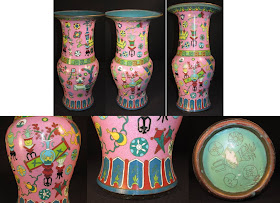The previous post discussing pink background enamel in Chinese cloisonne mentioned the collection of Edward Gerber. Doctor Gerber passed away in 2013; Clars Auction Gallery was responsible for the sale of items from his estate.
Among the items up for auction was what seems to be a unique assemblage of Chinese cloisonne items with a bright pink background enamel and a resemblance to a pair of vases with a rare Jingyuantang (静远堂) signature that possibly date from before World War I.

While the Gerber pieces share a similar "hundred treasures" design, the bases of many of the items have an unusual and distinctive feature: rather than a circle inset into the base, they feature an enameled cap applied over the bottom edges.
There are many designs, from small soap dishes and tea sets to large jars and vase pairs.
 |
| The LiveAuctioneers.com database of past sales can be searched to view the Gerber auctions. Note the pair of stacked cylinder dishes toward the back of the top shelf. More about a similar set below. The small vase at bottom right displays a double happiness motif. |
 |
| The vase displays a pattern at the base similar to one found on porcelains; the floral pattern is old-fashioned, and the double happiness characters seem to link it to the Jingyuantang vase; the "tiger" (?) handles and overall shape, rim, pale green turquoise enamel link it to the other examples in the collection (is it a mate to the vase bottom right previous picture?). Again, the complete set of cups and cupholders seems unusual - how did these pieces stay together so long? Online auction. |
 |
| A pair of warming dishes. |
 |
| Vase Pair 1 compared with similar Vase Pair 2 |
 |
| Vase 3 details |
 |
| Vase Pair 2 and Vase 3 comparison. |
 |
| Three views of pink jar |
 |
| Blue turquoise jar pair from another auction, not the Gerber collection |
 |
| Another non-Gerber jar, this time in a green turquoise |
 |
| A non-Gerber jar photographed in daylight. |
 |
| Comparison of Gerber jar with blue turquoise jar. |
 |
| Comparison of the green turquoise jar with the pink jar with similar large vase motif. |
 |
| An old-fashioned perforated hat stand from a 2015 auction, similar but not identical to the Gerber pair pictured above. |
 |
| Another hat stand pair. Note the similarity of the twin fishes vase motif to that on the Jingyuantang vase pair at the start of this post. The dotted base rim can be seen in other pieces above. |
 |
| A cylinder vase in the style of a hat stand. |
 |
| A blue turquoise vase in hat stand-style. According to Arthur & Grace Chu, orange enamel was a development of the 1970s, so this is perhaps a more recent production? |
 |
| A teapot from another auction. |
 |
| A dish and small vase from other auctions. |
What to make of this puzzling evidence? How to account for the similarity between the Jingyuantang vase pair and other pieces?
- Are they all pre-World War II products from the same workshop? 1910s-1930s? Are some - or all - post-World War II reproductions? 1970s?
- Where did Dr. Gerber purchase them - in Hong Kong or Taipei, before mainland China was opened to U.S. visitors in 1972? In Beijing or Shanghai or Hong Kong during the 1970s or early 1980s?
- How did Dr. Gerber find so many of them, with pairs of items still intact?
And now for something completely different:






























Great poster! The pair of pink basins in your Oct 14 poster were also part of Gerber estate and were the pair I mentioned on my comment on your Oct 9 poster. I believe from color, pattern, surface, they were exported in the end of 19th century.
ReplyDeleteMore on those beautiful basins in today's post:
Deletehttp://www.beadiste.com/2015/10/puzzling-evidence-pink-cloisonne-and.html
This comment has been removed by a blog administrator.
ReplyDeletecomment contained personal email address, so I thought it best to not publish it. About the beads, the writer says,
Delete"There are 8/8 sided tabular belt beads. 4 have blue dragon/maroon dragon and 4 have phoenix/Blue dragon on reverse. They all seem to be copper with a silver wash. I found them at a very tiny and primitive antique shop on Hwy 90 Bat St. Louis ,Mississippi pre 1990's and luckily pre-Katrina."
We're working on getting the photos visible as a blog post update.
Pictures of this interesting set of beads now available as an update at the end of this post about Deco-era belts with this kind of bead:
Deletehttp://www.beadiste.com/2015/03/puzzling-evidence-mysterious-belts-and.html